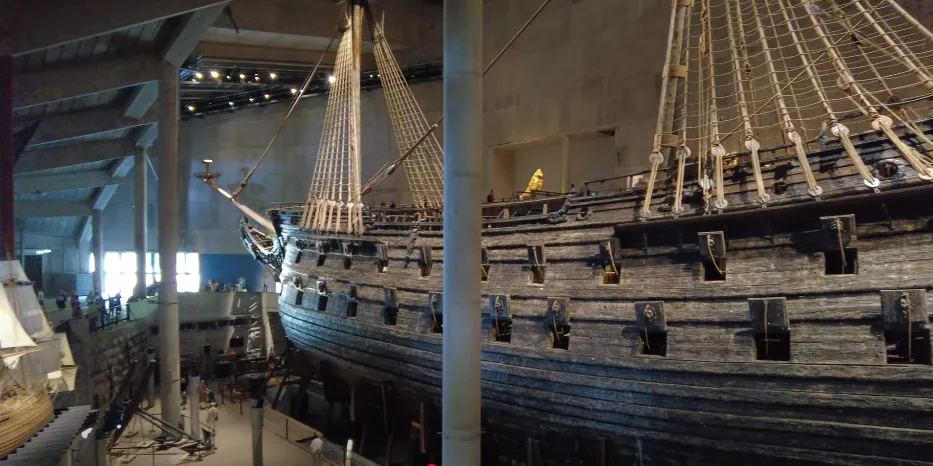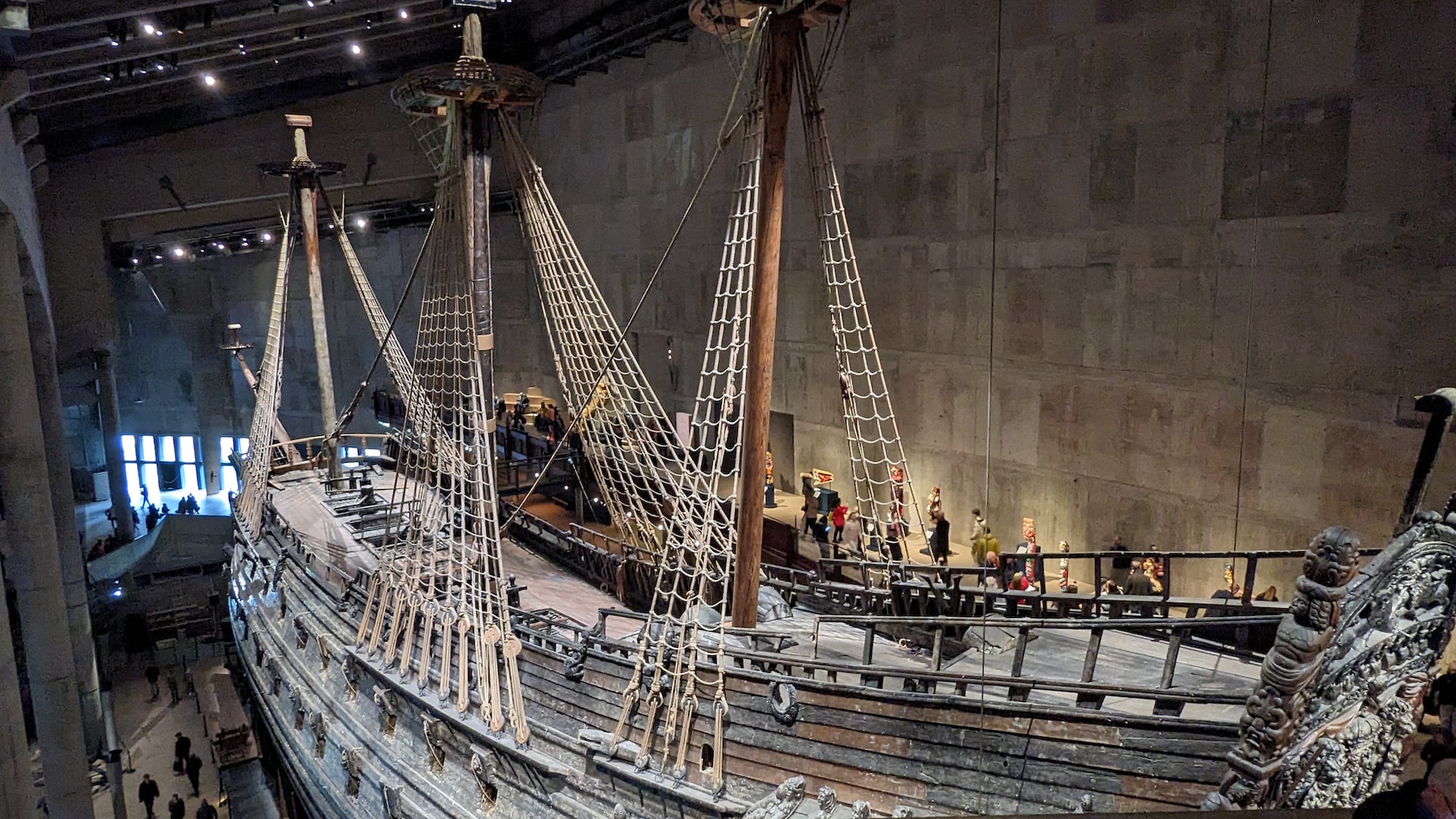“The Vasa Museum not only showcases the remarkable preservation of the Vasa warship but also serves as a vital educational resource, illustrating the complexities of 17th-century naval architecture and maritime history.” — Anders Franzén.
Stockholm is full of history, and the Vasa Museum is a must-see. When my friend and I decided to visit, we thought it would be interesting. But what we saw was even more amazing than we expected.
When we visited, we were amazed by the size of the ship and the exhibits. They showed its history so well that it felt like we went back in time. We didn’t just see a ship; we learned about a whole era. It’s clear why people from all over the world come here. It’s a must-see in Stockholm.
The Vasa ship took my breath away. It stood tall and grand, towering over us. This 17th-century warship is the heart of the museum and a true work of art.
The best part? It’s not just for history lovers. Even if you don’t usually like museums, this one will amaze you. I promise. If you’re in Stockholm, don’t miss the Vasa Museum. It’s a place you’ll remember long after you leave.

Exploring the Museum
The Vasa Museum isn’t just about the ship. As we walked through the halls, we saw amazing exhibits that told the story of the Vasa. One of my favorites was the reconstruction of what the crew might have looked like, based on their bones. Seeing their faces made the experience feel more real. Another highlight was the display of items found with the ship—tools, weapons, clothes, and even food. Each item told a story and showed what life was like in 17th-century Sweden.
Stepping Back in Time: The Vasa Ship

As soon as I stepped into the Vasa Museum, I was amazed by the size and beauty of the Vasa ship. This 17th-century warship was once the pride of Sweden’s navy. Sadly, it sank on its first voyage in 1628, just 20 minutes after setting sail. In 1961, it was raised from the waters of Stockholm’s harbor. Now, it stands tall and beautifully preserved in the museum.
At first glance, the ship’s size is amazing. It’s nearly 70 meters (230 feet) long, with tall masts that take your breath away. As I walked around the ship, I couldn’t help but admire the detailed carvings and sculptures on the ship. They’re mostly intact, showing just how skilled the craftsmen were back in the day.
What’s Inside the Vasa Museum?
1. The Vasa Ship: A Glimpse into the Past
The first thing I noticed about the Vasa was how well it was preserved. The museum has done an amazing job keeping the ship intact. Over 95% of the original structure is still there, thanks to the special conditions of the brackish water in the Baltic Sea. The colors of the carvings, the lifelike sculptures, and even the painted woodwork give a rare look into Sweden’s 17th-century naval dreams.
Standing beneath the ship, I was amazed by its size and detail. I spent a lot of time looking at the intricate carvings of mythical figures, including gods and kings, on the ship’s stern and bow. The Vasa was built to show off Sweden’s growing empire and its naval power. Even though it only sailed for a short time, it truly embodied that vision.
Construction And Design
The Vasa Ship was commissioned by King Gustavus Adolphus in 1625. Its primary purpose was to strengthen Sweden’s naval fleet. The ship was constructed at the Stockholm shipyard by master shipbuilder Henrik Hybertsson.
Standing at an impressive height of 52.5 meters, the Vasa Ship featured two gun decks. This made it one of the most formidable warships of its time. It was adorned with intricate carvings and painted in vivid colors.
The Vasa Ship’s design included 64 bronze cannons, making it a powerful weapon. The ship’s hull was constructed from oak, providing durability and strength.
Sinking Of The Vasa
The Vasa Ship met a tragic fate on August 10, 1628. It set sail on its maiden voyage but sank after traveling just 1,300 meters. The ship’s top-heavy design caused it to capsize in a slight gust of wind.
The ship’s sinking was a national disaster. It claimed the lives of around 30 crew members. The ship remained on the seabed for over 300 years until it was salvaged in 1961.
Today, the Vasa Museum houses the ship and tells its story. Visitors can explore the ship’s history and marvel at its grandeur.
Discovery An d Salvage
The Vasa Museum in Stockholm, Sweden, offers an incredible glimpse into maritime history. One of the most fascinating aspects is the ship’s discovery and salvage. The journey from the seabed to the museum is a tale of determination and ingenuity. Below, we delve into the key moments of the rediscovery and the salvage operation.
Salvage Operation
The salvage operation of the Vasa was a massive undertaking. It began in 1961, five years after its rediscovery. The operation required meticulous planning and state-of-the-art technology. The Swedish Navy played a crucial role. They collaborated with engineers and divers to lift the ship.
The team used cables to wrap around the Vasa. These cables were attached to pontoons. Slowly and carefully, the ship was lifted from the seabed. This process took several stages to ensure the ship’s integrity. Once lifted, the Vasa was transported to a dry dock. There, it underwent extensive conservation efforts.
Today, the Vasa stands as a testament to Swedish maritime heritage. Visitors can marvel at its grandeur and learn about its dramatic history.

2. Engaging Exhibits and Interactive Displays

The museum is designed so that the Vasa is the main focus, but it’s not the only highlight. There are many interactive exhibits, 3D models, and multimedia presentations that tell the story of the ship. From its ambitious building under King Gustavus Adolphus to its tragic sinking and later recovery, these exhibits help you understand the full history of the Vasa.
One of my favorite parts was the detailed display about how the ship was built. The Vasa was meant to be a technological wonder, but its design flaws — like an unstable hull and not enough ballast — caused it to sink. As I walked through the exhibits, I could see where the shipbuilders made mistakes, and I couldn’t help but feel a little sympathy for the engineers. They were ambitious, but perhaps too confident in their plans.
3. The Archeological Journey: Unearthing the Past
The story of the Vasa’s discovery and salvage is equally captivating. After sinking, the Vasa remained submerged for over 300 years, almost forgotten, until it was rediscovered in 1956. The museum offers an in-depth look at the archeological techniques used to recover the ship. It was fascinating to see photographs and videos of the recovery process, including the careful work done to raise the ship from the bottom of the sea.
Additionally, there are many artifacts from the shipwreck displayed, including personal items that were recovered from the ship’s hull, providing insight into the lives of the sailors who perished with the ship.
4. A Focus on Life Aboard the Vasa
As I explored further, I was struck by the exhibit dedicated to life aboard the Vasa. The museum provides a glimpse into what it would have been like for the crew, including their living conditions, daily routines, and the challenges they faced on this ill-fated voyage. One detail I found particularly fascinating was the reconstruction of the ship’s lower deck. It’s incredible to see how cramped and uncomfortable life must have been for the sailors, especially considering the fact that the Vasa was designed for warfare, notRestoration Efforts
The Vasa Museum in Stockholm, Sweden, is home to the well-preserved warship, the Vasa. The ship sank on its maiden voyage in 1628 and was salvaged in 1961. Since then, meticulous restoration efforts have been underway to preserve this remarkable piece of history for future generations.
Museum Exhibits
The Vasa Museum in Stockholm is a must-visit for history lovers. The museum houses the majestic Vasa ship, which sank on its maiden voyage in 1628. The exhibits offer a glimpse into 17th-century maritime history, making it a fascinating experience.
Permanent Exhibits
The permanent exhibits are a treasure trove of historical artifacts. They include:
The Vasa Ship – The centerpiece of the museum. Marvel at its grandeur and intricate details.
Life on Board – Learn about the daily life of sailors aboard the Vasa.
Shipyard – Discover the shipbuilding techniques of the 17th century.
Preservation – Understand the efforts to preserve the Vasa ship for future generations.
Each exhibit offers detailed information, making the visit both educational and engaging.
Temporary Exhibitions
The museum also features temporary exhibitions. These exhibits change periodically, offering fresh and exciting content. Some past exhibitions include:
Women on Board – Highlighting the roles of women on ships.
War and Peace – Exploring the naval battles of the 17th century.
Viking Voyages – Delving into the world of Viking explorers.
These temporary exhibitions provide new perspectives and keep the museum experience dynamic.

Educational Programs
Are you planning a visit to the Vasa Museum in Stockholm, Sweden? The museum offers a wide range of educational programs that cater to both children and adults. These programs aim to deepen your understanding of the historic ship and its fascinating history. The educational activities include workshops, lectures, and interactive learning experiences. Let’s dive into the details below.
Visitor Experience
The Vasa Museum in Stockholm offers an unforgettable journey through maritime history. Visitors can explore the well-preserved 17th-century ship, the Vasa, and immerse themselves in Swedish heritage.
Guided Tours
For a deeper understanding, join one of the guided tours. Knowledgeable guides share fascinating stories and details about the ship’s history. Tours are available in several languages, including English, to cater to international visitors.
English tours available
Detailed historical insights
Interactive and engaging
Museum Amenities
The museum offers several amenities to enhance your visit. Enjoy a meal at the on-site restaurant, which serves traditional Swedish dishes. The museum shop offers unique souvenirs and books related to the Vasa.
Amenity | Description |
|---|---|
Restaurant | Serves Swedish cuisine |
Shop | Sells souvenirs and books |
Accessibility | Wheelchair accessible |
Other amenities include free Wi-Fi and seating areas for relaxation. The museum is fully wheelchair accessible, ensuring everyone can enjoy the experience.
Vasa In Popular Culture
The Vasa Museum has also left its mark on popular culture. The ship has been featured in various forms of media. It has inspired books, documentaries, and even movies. The museum itself is a popular tourist attraction, drawing millions of visitors each year.
Popular Culture Highlights:
Appearances in documentaries and TV shows
References in literature and movies
Exhibits in museums around the world
The Vasa Museum remains a symbol of Sweden’s rich maritime history. It continues to captivate and educate people from around the globe.

Why the Vasa Museum is a Must-Visit
This museum isn’t just about history—it’s about storytelling, craftsmanship, and the resilience of human effort. Whether you’re a history enthusiast, a casual traveler, or simply someone looking for a unique experience, the Vasa Museum offers something unforgettable.
As we left the museum, I turned to my friend and said, “This place isn’t just a museum—it’s a journey back in time.” And it truly is.
Plan Your Visit
Location
Vasa Museum, Galärvarvsvägen 14, Stockholm, Sweden
Opening Hour

Ticket

For ticket Please Click Here
Conclusion
Visiting the Vasa Museum in Stockholm offers a unique historical experience. The well-preserved ship tells a fascinating story from the 17th century. The museum’s exhibits make learning fun and engaging. It’s an ideal spot for families and history enthusiasts alike.
Plan your visit to explore this captivating piece of maritime history. Don’t miss the chance to witness the grandeur of the Vasa ship. Your trip to Stockholm would be incomplete without it. Enjoy a memorable day at the Vasa Museum, where history comes alive.






